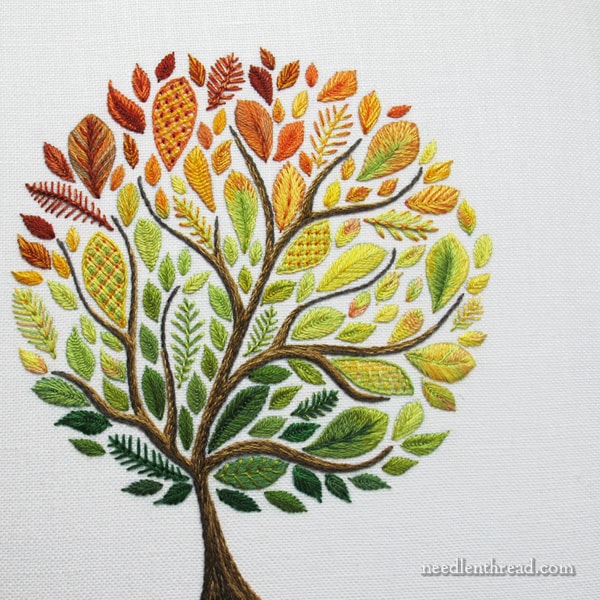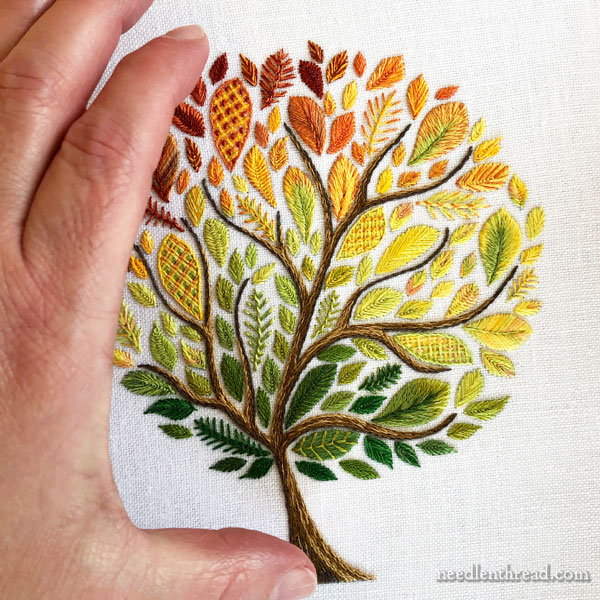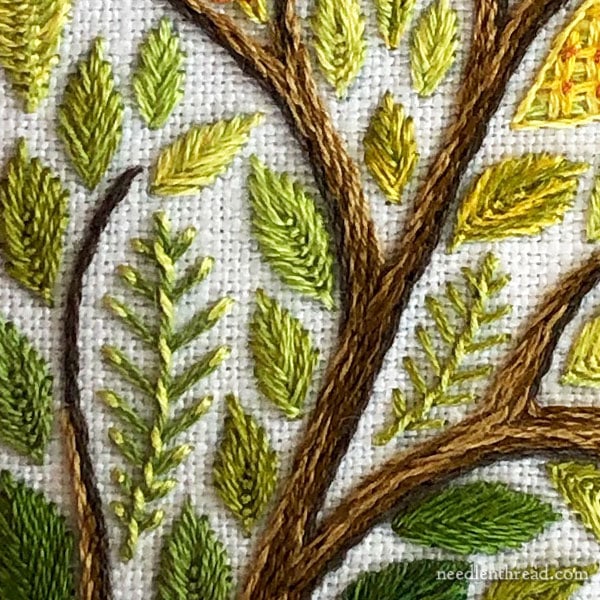When I first started exploring embroidery with any seriousness, one of my favorite resources was this old (as in almost 100 years old) book on ecclesiastical embroidery.
Whenever I looked at that old book, I yearned to see the details of the embroidery in those black and white photos. The photos were good – but most of them were never detailed enough for me. I used a magnifying glass at one point, thinking it might give me better detail. But the detail you can see in a photo is only as good as the detail caught by the camera.
Fast forward to today. The digital camera and the smartphone have completely changed not only the way we take pictures, but also the way we view them. The high-resolution digital picture has a marvelous capacity for zooming in on the details.
And this is beneficial for embroidery explorations – but it has a drawback here and there, too, which we’ll chat about below.
Case in point: the finished leafy tree I shared with you on Friday.
This is the photo of the finished piece that I shared with you:

It wasn’t long before the influx of email and comments on the tree brought me to a certain realization. This is something I’ve struggled with for a while on the website, but I’m never quite sure how to balance the problem.
Normally, when I post photos of embroidery on Needle ‘n Thread, on the viewer’s end, you’re experiencing the detail of the embroidery, close-up. You aren’t necessarily viewing the embroidery as the eye would normally see it.
At a regular range, the eye doesn’t see a piece of needlework in such minute detail. It sees the overall piece, and to see it in very close detail, you either have to get very close to it, look at it under magnification, or view a digital image of it, zoomed.
Realization Dawns
Several folks suggested finishing ideas for the tree – answering the “what are you going to do with it” question.
A few people suggested turning it into a family tree and stitching family members’ names, dates of birth and the like on the leaves.
Some suggested finishing the tree as a large decorative pillow for the sofa.
It was at this point that I realized that the size of the tree hasn’t really come across in any of the photos I’ve shown you.
Even if I were to give the dimensions of the tree, it’s still hard to fathom size, when you’ve been used to seeing the details of the piece.

So I took a photo that might help give you some perspective on the size.
The whole tree design, including the trunk, is just sightly over 5″ tall and just over 4″ wide. Having my hand in the photo helps give some perspective on the size. It also draws you back from the embroidery, so that you can see it more as your eyes would normally see it.
So this is one drawback of using detailed, close-up images when talking about embroidery: it’s easy to lose perspective on the actual size of a piece.
Material Impressions
The other drawback has to do with the materials used in the embroidery.
If you take that photo above, with my hand in it to give some perspective on size, and you zoom in on the very same image, you can come up with a picture like the one below, which is similar to many of the images I’ve shared with you for this tree:

When you see a cropped image like this, which gives you a very detailed look at a small section of the photo, you might have the impression that the linen used for the project is, perhaps, a lower count, somewhat rough linen. You also might have the impression that the threads are heavier than they are.
In fact, the linen is a high count linen, and it’s smooth. When you’re standing back from the piece – check out the first picture in this article – you might see that it’s linen, but you don’t see the weave nearly as distinctly. The fabric looks smooth and solid, as it is.
And the threads? The tree is stitched mostly with two strands of cotton floss taken from the normal six. Some leaves (specifically satin stitch and long and short stitch) are embroidered with one strand of floss.
So those are two drawbacks to the detailed images we can get using digital photography and cropped images, from the point of the view of the viewer.
The Stitcher’s Drawback
There’s another drawback, and it can be a Big One, but it falls on the shoulders of the embroiderer sharing the images rather than on the viewer.
I think many of the needlework bloggers out there could attest that sharing detailed, close-up photos of needlework puts a little pressure on the embroiderer to be very precise when stitching.
This can be a good thing – for me, it is a motivation to be extra attentive when I’m embroidering – but it can also be a little discouraging, because I might not see certain “mistakes” or flaws until I edit my photos. At that point, it’s often too late to do anything about it.
And, unfortunately, if the mistake or flaw shows up in a close-up image online, viewers might raise a collective eyebrow or judge the piece (or the embroiderer’s skills) more strenuously – when, in fact, in normal viewing circumstances, they’d never see it.
On the bright side, if such “mistakes” or flaws aren’t really visible to the naked eye under normal circumstances, do they even matter? No, not really!
And on the other bright side, if the mistakes are discernible, they turn into good teaching moments. There’s nothing quite as effective when teaching hands-on, as making a mistake and showing how to fix it.
What Was Your Impression?
I’d be curious to know if you realized, before seeing the perspective photo with my hand in it, how small the tree is. Did you think it was larger? Or was that about the size you imagined it? Feel free to weigh in with your impressions in the comment section below.
For those who have asked, I’ll be releasing the Leafy Tree here on Needle ‘n Thread as soon as I tie up some other project loose ends! Keep an eye out for it in the not-too-distant future.

















